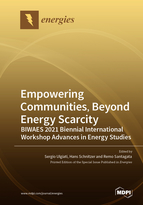BIWAES 2021—Biennial International Workshop Advances in Energy Studies "Empowering Communities, Beyond Energy Scarcity"
A special issue of Energies (ISSN 1996-1073). This special issue belongs to the section "B: Energy and Environment".
Deadline for manuscript submissions: closed (25 December 2021) | Viewed by 40900
Special Issue Editors
2. State Key Joint Laboratory of Environment Simulation and Pollution Control, School of Environment, Beijing Normal University, No. 19 Xinjiekouwai Street, Beijing 100875, China
Interests: life cycle assessment; energy–exergy–emergy; environmental impact assessment; circular economy; urban metabolism and sustainability; food and water security; disparity in access to energy sources; large efforts invested in energy and resource efficiency, prosperous way down, and environmental integrity
Special Issues, Collections and Topics in MDPI journals
2. StadtLABOR – Innovation for Urban Sustainability, Griesgasse 40, 8020 Graz, Austria
Interests: energy efficiency and renewable energies for production processes and urban systems; water-energy nexus; life-long learning system in many aspects of sustainability
Interests: environmental impact assessment; environment; sustainability; renewable energy technologies; energy engineering; environmental analysis; environmental management; sustainable development; power generation; environmental pollution
Special Issues, Collections and Topics in MDPI journals
Special Issue Information
This Special Issue refers to the 11th edition of BIWAES, which will take place in parallel to the European Roundtable “Consumption and Production in a plus 1.5°C World”, Graz (Austria), 8. – 10. September 2021, www.erscp2021.eu.
A new energy scarcity
Energy is a fundamental resource for societal and economic metabolisms; not only do we need energy, but we clearly need to address crucial questions about its use (energy to do what? energy from where?) and appropriate management (top-down vs. bottom-up energy policy making). As is well known, a new kind of energy scarcity is occurring, not only due to limited abundance, but increasingly due to environmental constraints and trade-offs, to unequal availability worldwide and market prices.
Achieving sustainable economies and shared wellbeing calls for an urgent re-framing of the energy problem toward a balanced mix of solutions. The latter include technological improvement, use of energy resources consistent with their thermodynamic properties, a selection of environmentally friendly sources and carriers, suitable approaches to monitoring of impacts, efficiency measures with rebound control, lifestyle equity and reduction of energy poverty, decrease in wasteful habits, recognition of environmental limits in a limited planet, and careful management of the energy-water-food-environment nexus.
Empowering Communities
Who is in charge for energy solutions? Scientists and technology experts have absolutely provided important contributions within Academy and Business, orienting energy policy making. However, some top-down solutions have not always shown the ability to fully address the needs of communities, nor have they promoted stakeholders and citizens’ participation toward tailored solutions for the different situations. It may be time to integrate top-down and bottom-up efforts in order to benefit from community insight and knowledge (be they regional, urban, neighborhood and condominium realities, rural organizations, developing communities worldwide) and see needs and solutions that are visible to local realities and not easily visible to experts and policy makers.
Interdisciplinary evaluations
It clearly appears that the energy problem cannot only be addressed in thermodynamic or technological terms. A deeper understanding of trends, solutions and policies can only be achieved through converging efforts by different disciplinary sectors, so that economic, social, environmental, cultural, and psychological expertise converges into an innovative picture of local and larger communities toward shared wellbeing.
Prof. Dr. Sergio Ulgiati
Prof. Dr. Hans Schnitzer
Dr. Remo Santagata
Guest Editors
Manuscript Submission Information
Manuscripts should be submitted online at www.mdpi.com by registering and logging in to this website. Once you are registered, click here to go to the submission form. Manuscripts can be submitted until the deadline. All submissions that pass pre-check are peer-reviewed. Accepted papers will be published continuously in the journal (as soon as accepted) and will be listed together on the special issue website. Research articles, review articles as well as short communications are invited. For planned papers, a title and short abstract (about 100 words) can be sent to the Editorial Office for announcement on this website.
Submitted manuscripts should not have been published previously, nor be under consideration for publication elsewhere (except conference proceedings papers). All manuscripts are thoroughly refereed through a single-blind peer-review process. A guide for authors and other relevant information for submission of manuscripts is available on the Instructions for Authors page. Energies is an international peer-reviewed open access semimonthly journal published by MDPI.
Please visit the Instructions for Authors page before submitting a manuscript. The Article Processing Charge (APC) for publication in this open access journal is 2600 CHF (Swiss Francs). Submitted papers should be well formatted and use good English. Authors may use MDPI's English editing service prior to publication or during author revisions.








